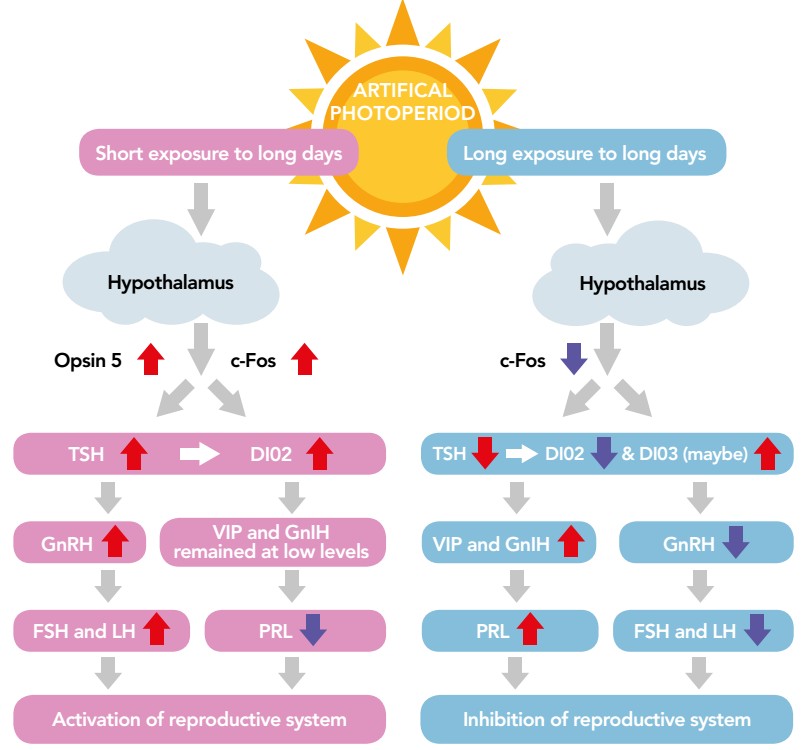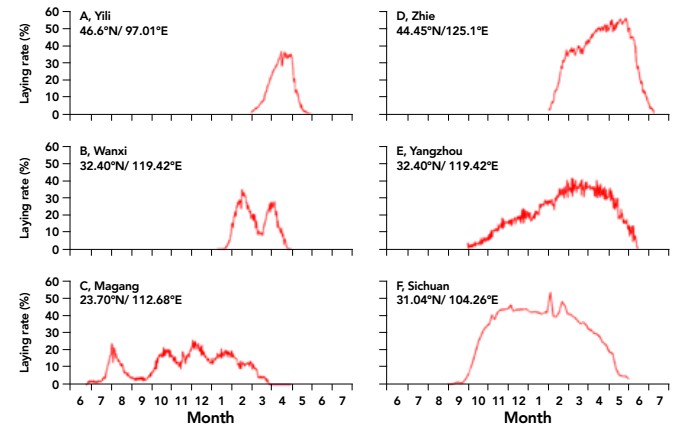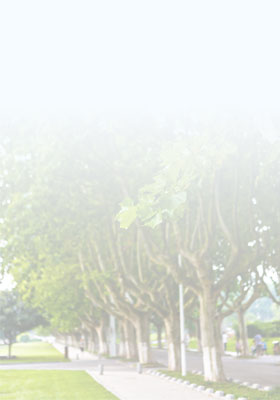Domestic geese are economically important waterfowl that supply eggs, meat and feathers to many parts of the world. The goose industry is particularly lucrative for China which, as of 2015, supplies over 90% of the world’s geese.
However, seasonal breeding behaviours restrict the production of goslings and commercial meat geese to a certain time of year. This causes large price fluctuations for the birds throughout the year and discourages goose consumption. Through their research, Professor Zhendan Shi of Jiangsu Academy of Agricultural Sciences and his team hope to induce continuous, year-round breeding in geese, leading to improved economic efficiency, sustainability, growth and modernisation of the goose industry.
Over the last 15 years, our team have sought to turn the goose industry on its head by changing breeding seasons in domestic geese by artificially changing their day length or ‘photoperiods’. Their approach is based on the theory that light signals detected by photoreceptors in birds’ brains can either stimulate (photostimulation) or inhibit (photorefractoriness) reproductive activities. In this theory, photostimulation occurs when photoreceptors in the brain set off a chain reaction of enzyme activities and nervous impulses that trigger hormone creation and secretion in the pituitary gland underneath the brain (as explained in Figure 1). These hormones, called gonadotrophins, stimulate gonad growth and development and sexual behaviour. Likewise, the photoreceptors can trigger the production of another set of hormones that lead to gonad regression and end the breeding season.
1. NATURE OF SEASONAL BREEDING
Seasonal breeding is a physiological mechanism that helps animals living in the wild to cope with the seasonal fluctuations in climate and food availability. Wild birds living in cold or temperate regions rely on seasonal breeding to ensure their young have maximal chances of survival. The timing and duration of their breeding season is based on seasonal changes in environmental conditions. In the case of geese, this is about harsh winters or long migrations, they continue to display seasonal breeding behaviours. This is also true of domestic geese living in warmer regions which have contrasting breeding seasons.
Based on studies conducted by our colleagues, that surveyed year – round egg-laying data from eight geese breeds, from north to south, throughout the vast area of China, geese can be categorised into one of three types based on their habitat locations and subsequent breeding seasonality: (1) Northern long day breeders – breeding occurs during the long days in spring and early summer, (2) Middle latitude long day breeders – breeding occurs in late autumn and ends in spring or early summer, and (3) Southern short day breeders – breeding starts in late summer and ends in spring.
The extended breeding season of type 2 geese (Yangzhou geese) is attributed to milder temperatures experienced in the temperate zones and less extreme changes in daily photoperiods. Meanwhile, the milder winters experienced by type 3 geese (such as Magang geese) living in subtropical zones allow them to continue their breeding season for most of the year. However, unlike the long day breeders, these geese do not fare well in summer.
2. A MATTER OF TIME
In practical production of the goose industry, the lack of eggs laid in summer interrupts gosling hatching and commercial goose production. This sends the prices of meat geese and goslings skyrocketing. Farmers therefore wish to be able to breed goslings out-of-season in the summer months. Our team first started to help farmers solve this seasonal breeding problem in the short-day breeding Magang goose in Guangdong Province. Treating birds with a very long photoperiod of 18 hours of light per day in winter months allowed them to stop egg laying. After the geese rested for two and a half months, and were ready for laying eggs again, a shortening of the daily photoperiod to 11 hours from early summer induced the geese to lay eggs again. This short 11-hour photoperiod helped to maintain good secretion of the pro-reproductive hormones, gonadotrophins, but depressed secretion of the reproduction-inhibiting hormone prolactin. Geese were able to manifest full egg laying activity. With this photoperiodic system, the egg laying capacity of Magang geese could be increased from the norm of 35–40 by 30% to 50–55. The story on the long day breeding Yangzhou geese is more complicated. In opposition to that used for the Magang geese, a simple photoperiod program (8 hours per day in winter, and 12 hours per day from spring to summer) was used to induce egg laying in summer months. However, the egg production performance following this regime is not very long, only yielding 45 eggs per bird. An additional treatment of a very long photoperiod of 18 hours for one month prior to the 8-hour short days, can prime the geese to synthesise higher amounts of pro-reproductive hormones or gonadotrophins FSH and LH, and enhance the egg-laying capacity to 55 eggs per bird. If the daily photoperiod is further shortened from the previous 12 hours to 11 hours, secretion of prolactin is depressed for much longer periods, and the reproductive system remains fully active accordingly, so egg production is further increased to 70–75 per bird.
While this may not sound important, it has huge implications for goose productivity when applied to industry. An increase in goose productivity translates to an increase in income for geese farmers which can have wider ranging economic benefts. As a result, our team suggested that the industry adopt a regime where geese are exposed to a cycle of relatively long photoperiods of 11 hours followed by shorter photoperiods of around 8 hours. However, this may vary slightly depending on goose breeding type.
That said, our team’s photoperiod programs can be used to synchronise sexual activities of long or short day breeding geese, allowing farmers to crossbreed geese with high effciency, which was previously very diffcult.
Apart from using the photoperiod, timing of gosling stocking is also important. By stocking goslings from January to May, farmers can ensure they’ll start laying as soon as they reach sexual maturity (7 or 8 months old). Conversely, goslings stocked from October to December would be inhibited from reproducing until at least September the following year, as the prevailing photoperiod would prevent reproductive activity.
3. IMPACT ON INDUSTRY
The ability to produce geese out-ofseason using artifcial photoperiods has signifcantly improved productivity and proft margins within the Chinese goose industry and caused farms to grow exponentially. In fact, annual production of commercial geese has increased at a rate of three to four percent per year since the technique was developed in 2000. Currently, there are 87 million commercial geese produced each year in Guangdong Province alone, compared to 41 million in 2000. The goose industry’s rapid growth has helped foster year-round consumption and encouraged enterprises to invest in goose production in anticipation of increasing market demands – particularly in north and east China. As a result, farmers using the out-ofseason lay technique have achieved net profts four to six times higher than those using natural reproduction of goslings and almost double those naturally producing commercial meat geese.
This has helped change farmers’ lives considerably. Where goose raising used to be a small-scale family side practice, it has now become a specialised, lucrative business. High earnings have helped farmers to not only improve their living standard, but also to educate themselves, as well as their younger generations. The latter are now more attracted to farming and developing agri-business, which adds new impetus to rural development. Our team expects this trend to continue with widening adoption of his out-of-season breeding technique and modernisation of the goose industry

Figure 1: Diagram of photoperiodic regulation pathways that regulate reproductive systems in geese. Light can penetrate the bird’s skull and activate photoreceptors such as opsin proteins that reside in the deep brain. Through a series of enzymatic reactions and hormone syntheses and regulations, GnRH is secreted by the hypothalamus. This drives secretion of gonadotrophins, FSH and LH, by the pituitary gland, which activates the reproductive system. On the other hand, inhibitive photosignals lead to the production and secretion of different hormones: VIP and GnIH. GnIH inhibits gonadotrophin secretion by the pituitary gland, while VIP stimulates secretion of another reproductive hormone called prolactin.

Figure 2: Egg laying curves of six indigenous geese breeds at different locations throughout China.

Figure 3: Diagram of increasing egg production in out-of-season breeding Yangzhou geese by improvement of photoperiod programs. Left panel, a simple program produces 45 eggs per bird. Middle panel, an additional 18 hour long photoperiod treatment increased egg production to 55. Right panel, shortening of daily photoperiod during out-of-season breeding in summer months further brought the egg laying performance to 70-75 per bird.
Publications:
1. Zhu, H., Chen, Z., Shao, X., Yu, J., Wei, C., Dai, Z., Shi, Z., 2017. Reproductive axis gene regulation during photostimulation and photorefractoriness in Yangzhou goose ganders. Frontiers in Zoology. 14, 11.
2. Zhu, H., Shao, X., Chen, Z., Wei, C., Lei, M., Ying, S., Yu, J., Shi, Z., 2017. Induction of out-of-season egg laying by artificial photoperiod in Yangzhou geese and the associated endocrine and molecular regulation mechanisms. Animal Reproduction Science. 180, 127-136.
3. Zhu, H.X., Hu, M.D., Guo, B.B., Qu, X.L., Lei, M.M., Chen, R., Chen, Z., Shi, Z.D., 2019. Effect and molecular regulatory mechanism of monochromatic light colors on the egg-laying performance of Yangzhou geese. Animal Reproduction Science. 204, 131-139.
4. Zhu, H.X., Liu, X.Q., Hu, M.D., Lei, M.M., Chen, Z., Ying, S.J., Yu, J.N., Dai, Z.C., Shi, Z.D., 2019. Endocrine and molecular regulation mechanisms of the reproductive system of Hungarian White geese investigated under two artificial photoperiodic programs. Theriogenology. 123, 167-176.
5. Huang, Y.M., Shi, Z.D., Liu, Z., Liu, Y., Li, X.W., 2008. Endocrine regulations of reproductive seasonality, follicular development and incubation in Magang geese. Animal Reproduction Science. 104, 344-358.
6. Shi, Z.D., Huang, Y.M., Liu, Z., Liu, Y., Li, X.W., Proudman, J.A., Yu, R.C., 2007. Seasonal and photoperiodic regulation of secretion of hormones associated with reproduction in Magang goose ganders. Domestic animal endocrinology. 32, 190-200.
7. Shi, Z.D., Tian, Y.B., Wu, W., Wang, Z.Y., 2008. Controlling reproductive seasonality in the geese: a review. Worlds poultry science journal. 64, 343-355.


